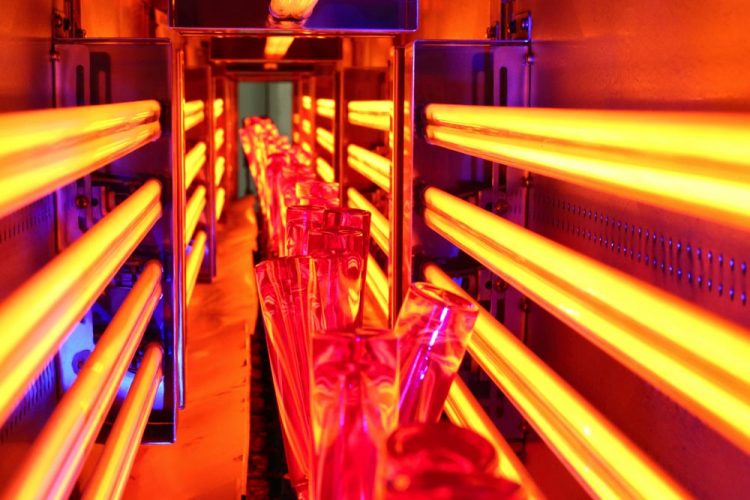A global first: Heraeus black.infrared increases efficiency of heating processes for semiconductor production

Heraeus black.infrared Application Glass Manufacturing
At the SEMICON Taiwan exhibition in Taipei at the beginning of September, Heraeus Noblelight will present black.infrared, a global first for the semiconductor and photovoltaics industry. The innovative infrared system functions according to a completely new emitter principle.
The flat, low-profile emitter is surrounded by quartz glass material, e.g. a specially developed quartz glass, and this combination helps transfer infrared heat very homogenously at a high energy density. This makes heating processes more efficient in both space and energy.
Wherever space is short and fast, homogenous heating is required, switching to black.infrared can significantly shorten process times and considerably improve quality, such as in microchip production.
The emitters are also suited for ultrapure processes and vacuum conditions. In contrast to conventional ceramic and metal emitters, the process can minimize impurities during wafer production. Rolf Diehl, Vice President of Heraeus Noblelight explains:
“Black.infrared was developed with the demanding requirements of semiconductor production and photovoltaics in mind. This combination of design and emitter technology is a revolutionary breakthrough for efficient, ultrapure heating processes under vacuum conditions.”
Innovation is particularly interesting for the semiconductor industry
Semiconductor process technology requires multiple thermal processes that dry or heat during the production of microchips, such as those used in smartphones. It is important in this process to avoid both chemical impurities in the microchips and particles from entering during the individual production process steps.
Even the tiniest trace impurities during manufacturing will result in a defective microchip, which is then unusable. The new Heraeus emitters use a specially developed quartz glass as a carrier material. Due to its high chemical purity (it consists solely of silicon and oxygen), it is optimally suited for these thermal processes. Black.infrared emitters have been constructed to allow for the greatest possible homogeneity at relatively close proximity. That helps to use the process space optimally.
Tests and development projects have shown that the new combination’s very high homogeneity and optimally adjusted emitters can contribute to greater energy efficiency. “The black.infrared emitter combines an infrared emitter in the medium wave range of around 2.5 micrometers with high optical performance for the first time. This combination is unique,” says Rolf Diehl.
In the future, additional industrial heating processes could also benefit from new infrared systems given that infrared emitters with medium wavelengths are particularly suited for glass, plastic and most coatings.
Heraeus Holding GmbH
Heraeusstr. 12 – 14
63450 Hanau
Germany
Phone: +49 (0) 6181/35-0
Fax: +49 (0) 6181/35-31 31
E-Mail: pr@heraeus.com
Media Contact
More Information:
http://www.heraeus.comAll latest news from the category: Trade Fair News
Newest articles

Combatting disruptive ‘noise’ in quantum communication
In a significant milestone for quantum communication technology, an experiment has demonstrated how networks can be leveraged to combat disruptive ‘noise’ in quantum communications. The international effort led by researchers…

Stretchable quantum dot display
Intrinsically stretchable quantum dot-based light-emitting diodes achieved record-breaking performance. A team of South Korean scientists led by Professor KIM Dae-Hyeong of the Center for Nanoparticle Research within the Institute for…

Internet can achieve quantum speed with light saved as sound
Researchers at the University of Copenhagen’s Niels Bohr Institute have developed a new way to create quantum memory: A small drum can store data sent with light in its sonic…





















